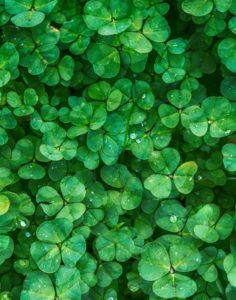Some links in the post are affiliate links and I get a commission from purchases made through some links found in the post.
Clover has always been an essential part of the gardening culture. Four-leaf clover has a historical reputation as a symbol of faith, love, hope, and success.
On the more practical side of things, clover is an excellent alternative to traditional grass turf lawns. It holds multiple benefits over grass lawns by virtue of its natural properties and sturdy nature.
The most striking quality clover possesses is its ability to grow without the help of any natural or artificial fertilizers.
This is because clover can produce nitrogen from the atmosphere with the help of microorganisms present in the soil. That is not all. It also competes with weed and other growths, which can harm your lawn.
If you are looking for a plant that will attract bees, then clover might be the ideal choice for your yard. Bees love clover because of its great pollen and nectar count.
Another plant that attracts bees is the marigold, read more here to find out what else the marigold attracts.
Another feature of clover which makes it so endearing to gardeners is its ability to tolerate droughts and stay green throughout the year.
So if you have chosen this beautiful plant as the new addition to your lawn, we would say you have made an excellent choice!
When Should I Plant Clover In Spring
 Every plant requires a specific time and a set of conditions for optimal growth, and clover is no different. Clover planting needs meticulous planning to avoid unfavorable weather conditions.
Every plant requires a specific time and a set of conditions for optimal growth, and clover is no different. Clover planting needs meticulous planning to avoid unfavorable weather conditions.
The ideal time to be planting clover is in the spring or late summer/ early fall when the frost has cleared away, and sunshine is plentiful. The temperature should be around 30-50 degrees Fahrenheit at night.
The perfect time for these conditions is between Mid April- Mid May in the USA. If you plant it too early or too late, your plant won’t grow successfully.
You should also consider the light and water requirements for your plant to be successful. Clover plants ideally require about 40 inches of rain and 4-6 hours of sunlight daily.
Planting your clover in the spring coinciding with the seasonal rainfall, and you will witness beautiful growth!
Can You Plant Red Clover In The Spring
Red Clover is commonly grown for forage and improving the quality of the soil. Because of its nitrogen-fixing abilities, it can increase the quality of soils in areas with excessive cropping.
Red clover can be grown on its own and in combination with other plants. However, some soils cannot grow red clover, mainly waterlogged, alkaline, or acidic soils.
The ideal time for planting red clover is late summers or early spring so that the plant is well established before the cold weather sets in.
On top of the other benefits, red clover is one of the most aesthetically pleasing crops you can grow!
You may also like: how To plant garlic in Colorado
Can You Put Down Too Much Clover Seed
People new to gardening should know the difference between overseeding and excessive seeding.
Overseeding refers to the process of sowing new seed into an already existing lawn, whereas excessive seeding means just laying down hefty amounts of seeds. You can put down too much clover seed.
The excessive seeds will remain dormant and can potentially cover any bare spots present in the lawn. But beware if you are growing clover in the company of grass.
Putting down too many clover seeds will cause your clover to outcompete grass because of its ability to remain in the soil for a long time.
How Fast Clover Grows From Seeds
 Clover can grow rapidly from seeds provided that the soil is prepared, and proper sowing methods are used.
Clover can grow rapidly from seeds provided that the soil is prepared, and proper sowing methods are used.
Before planting your clover you should remove any new weeds from your lawn and create a smooth and even texture.
Clover seed should be mixed with different components like fine soil, sand dust, or sawdust for a successful plantation.
Make sure the distribution is equal in all areas. Follow these steps and your clover seeds can sprout anytime between 2-3 days.
How To Plant Clover In An Existing Lawn
Clover can grow pretty rapidly in an existing lawn as well. If you are looking to plant clover on your lawn, you should mow the grass close to the ground and remove any weed present.
The next step is to thoroughly aerate your yard once you cut the grass and eliminate any outgrowths.
Clover benefits tremendously from aeration. Finally, mix clover with fine soil or sand and distribute it evenly over your desired area.
After sowing seeds, you need to water your seed daily for up to two weeks. This will give your clover the moisture it requires for growth and adapting to the soil.
Make sure to keep any cattle away from the soil because cattle can graze your newly planted clover very quickly.
A crucial tip for growing clover successfully in an existing lawn is to reduce the use of nitrogen-based fertilizers.
Clovers don’t need fertilization because of their natural nitrogen-fixing abilities; hence cutting down on fertilizers will give clovers an edge over grass or any other competing plant.
You can use fertilizers with a low nitrogen ratio because your new plantation does require phosphorus and potassium.
Will Clover Take Over Grass
Clovers can take over grass in the presence of the right conditions. Compacted soil, depleted nitrogen levels, low grass, and wrong soil pH are optimum conditions for clover growth.
So if you are growing clover with another plant, you need to beware of these conditions.
If you want to prevent clover from choking your grass, you need to take care of a few things. First and foremost, fertilize your lawn regularly with a nitrogen-based fertilizer.
In contrast to clover, grass needs fertilizers for nitrogen requirements. So in a well-fertilized lawn, the odds of clover taking over grass are significantly lower.
Water the lawn deeply but not too frequently. In this way, your grass will establish deep roots. These are some of the ways how you can prevent clover from choking your grass.
Final Thoughts: Planting Clover in Spring
 Clover is an environmentally friendly solution to traditional grass because of its nitrogen-fixing properties. They are very easy to grow because of their flexible water and temperature requirements.
Clover is an environmentally friendly solution to traditional grass because of its nitrogen-fixing properties. They are very easy to grow because of their flexible water and temperature requirements.
The benefits of growing clover extend to their edible and medicinal properties as well. You can use them in salads as part of a healthy diet.
They are rich in vitamins and anti-inflammatory substances. If you are still not impressed, clovers do not require a lot of maintenance.
They stay green throughout the year and are breathtaking in full bloom. Finally, clovers also attract bees and other insects, protecting your lawn from harmful organisms.
To grow clover successfully, you need to provide the right temperature and moisture. Keep cattle away from your yard to protect your clover, and you will have a beautiful lawn soon!
Before you go, here are some more related articles I encourage you to read below to help solve more of your gardening issues:
How much sun does lettuce need
How to Plant Blueberries in Oregon
5 Great Planting Combinations With Your Agapanthus
How to Use an Arborvitae in Your Landscaping
About the Author:
Saad Ansar
Saad is an avid gardener himself and is a great lover of plants, animals, photography, & people. Currently, he is focused on photographing indoor plants & captioning beautiful outdoor sceneries. He writes and rewrites in-depth articles on nature and science.


